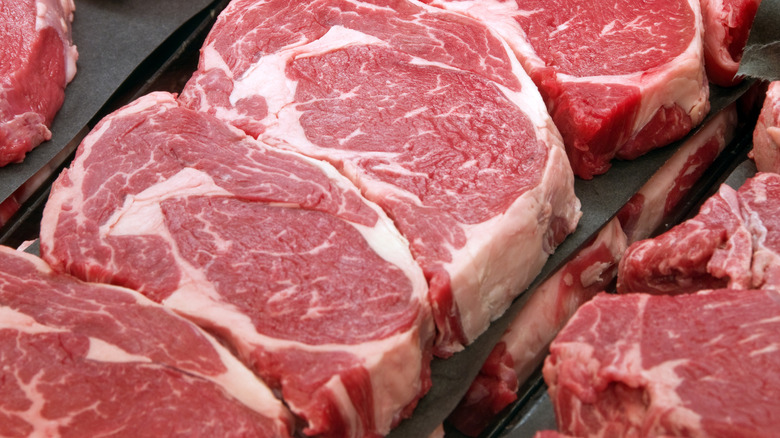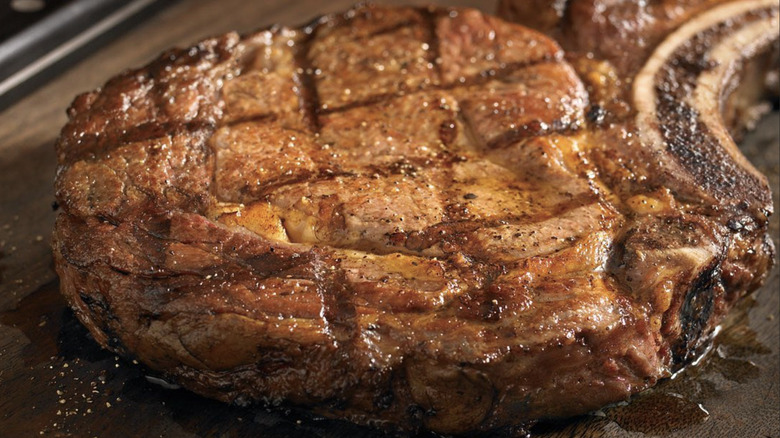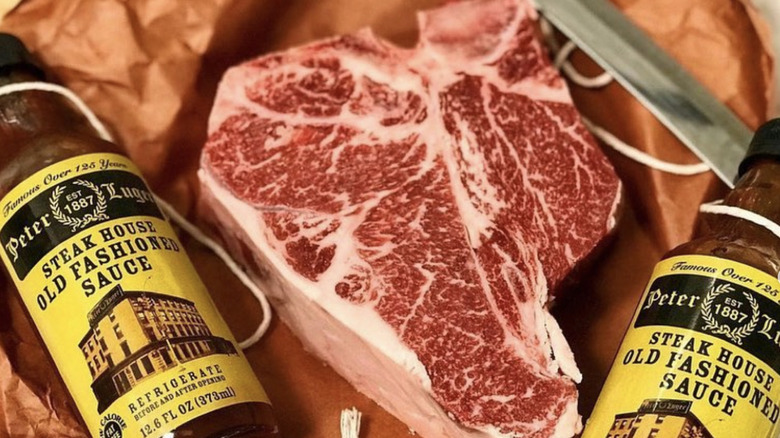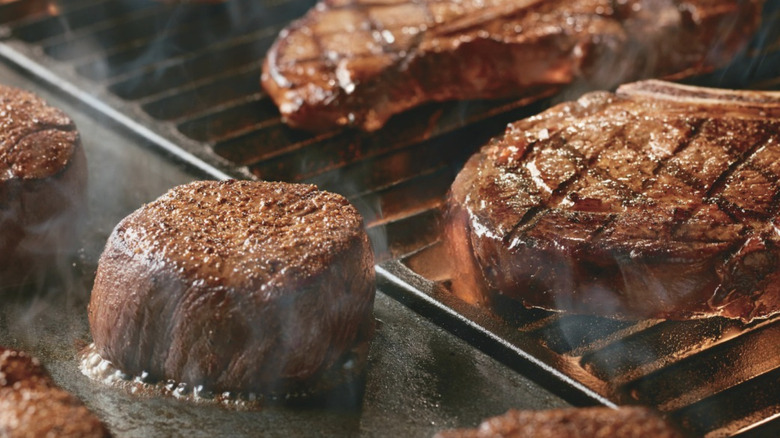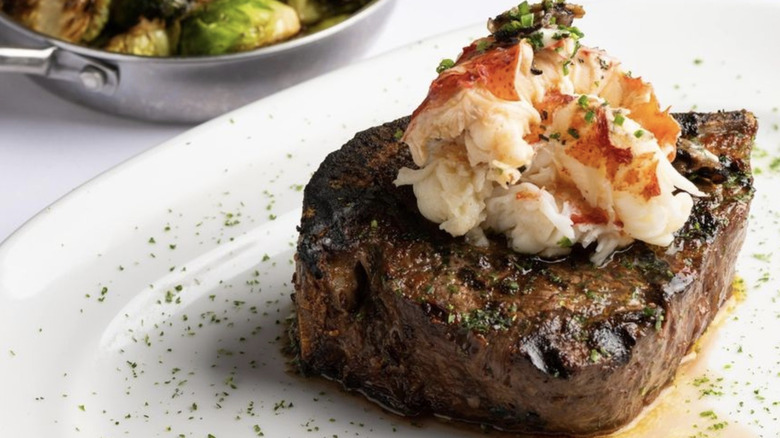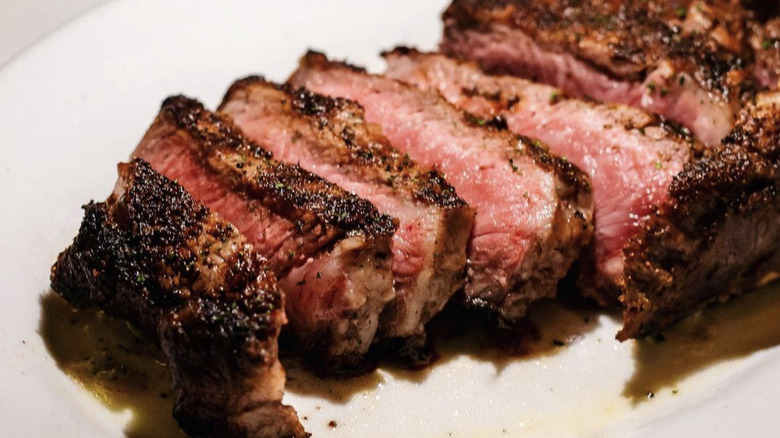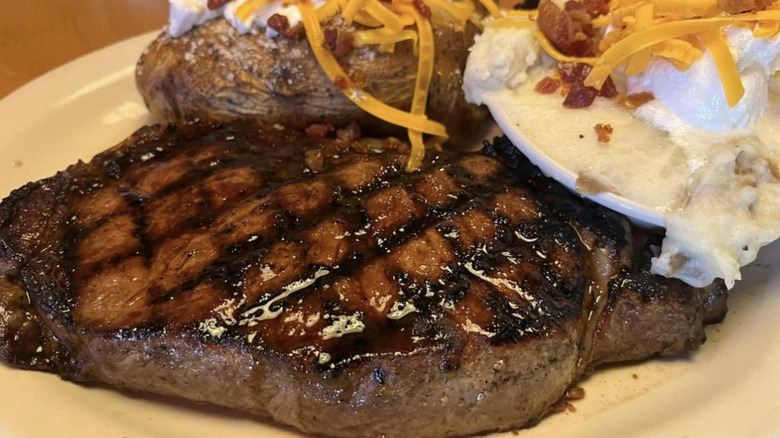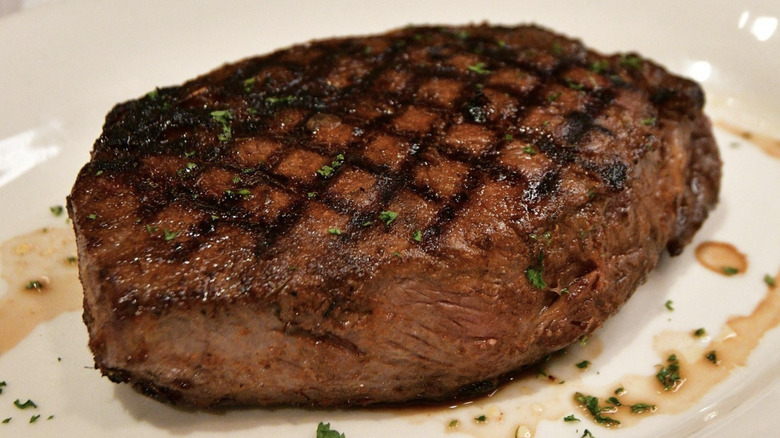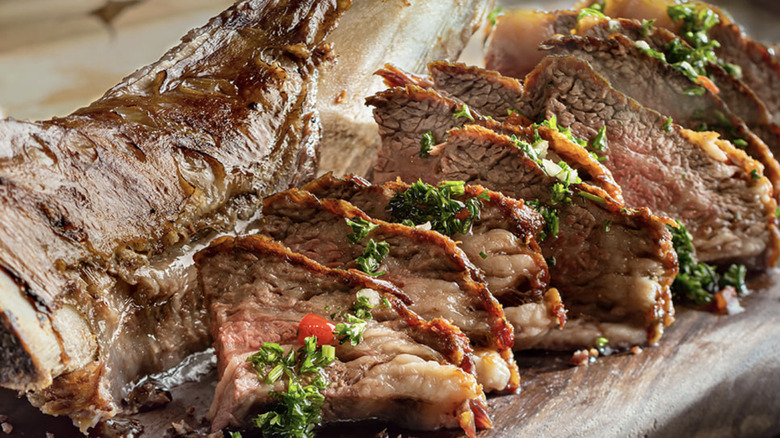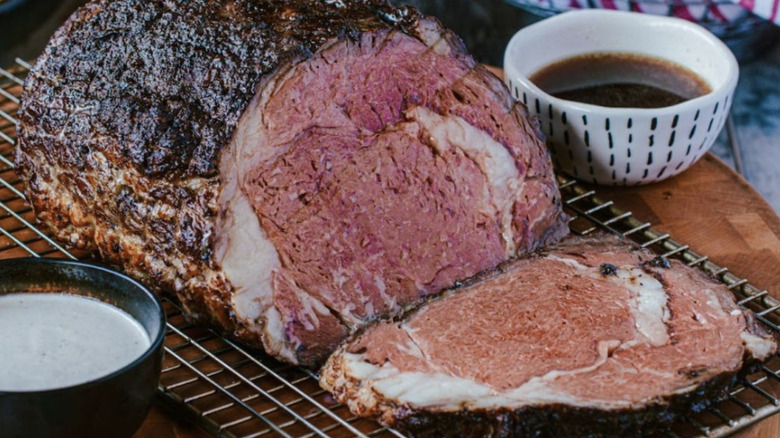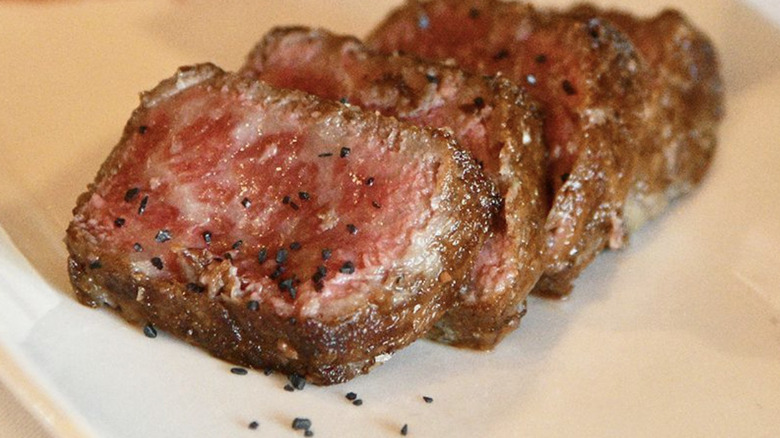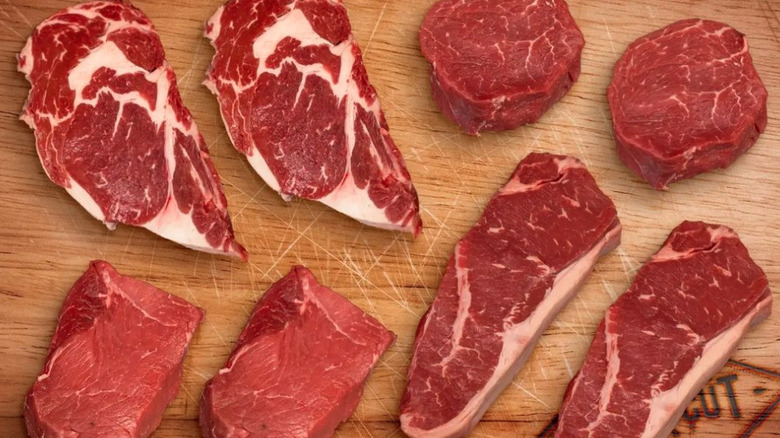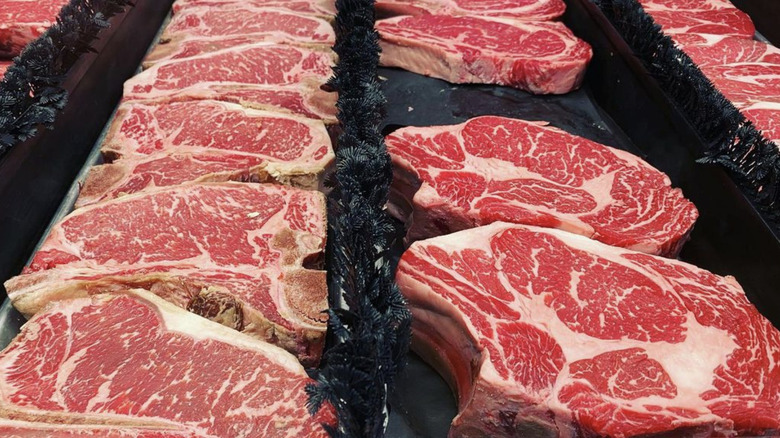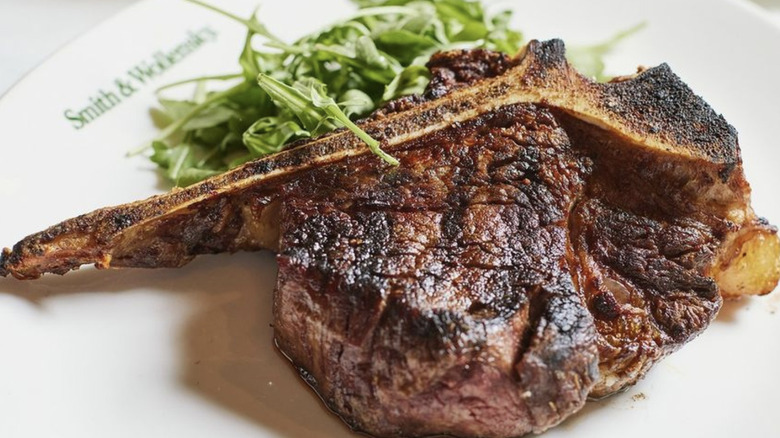Steakhouses That Never Use Frozen Steak
Food trends may come and go, but steakhouses will never go out of style. Whether sizzling with rustic charm or unapologetically upscale, steakhouses offer a broad appeal. There are tens of thousands of steakhouses in the United States, and if you want to dig into your favorite cut in a restaurant setting, we're going to guess that you'd prefer the meat to be fresh, not frozen.
The good news is that steak lovers don't have to splurge on an expensive restaurant to indulge in quality steak — plenty of casual sit-down chains take beef quality seriously and don't keep the steaks in the freezer. The other good news is that many steakhouses in the fine dining realm have uncompromising views on how the steaks are aged and cooked, so if you do want to drop some extra cash at a high-end spot, never-frozen steak is the general expectation.
In the mood to make it a steakhouse night but not sure where to turn? To help you on your way, we've investigated how some of the most popular steakhouses in the country approach preparing steak. And if that process happens to involve thawing, those restaurants didn't make the, uh ... cut. Take a look at our list of steakhouses that never use frozen steak.
Outback Steakhouse
If you are a steak fan, chances are you've been to Outback Steakhouse at least once. The Australian-themed eatery doesn't actually hail from Down Under — it originated in Tampa, Florida in 1988. With over 30 years in the steakhouse game, Outback is still going strong. It is America's most widespread steakhouse chain with nearly 700 locations nationwide. One of the business practices that makes Outback successful is its commitment to never freezing its steak.
Outback Steakhouse's parent company, Bloomin' Brands Inc., instills confidence in fans of its famous restaurant, saying, "Our tender, juicy steaks begin with only the finest beef. They are aged to perfection in a controlled environment to ensure tenderness, seasoned with our secret blend of herbs and spices, and grilled to each customer's preference."
The chain uses USDA Choice beef, a step down from the USDA Prime beef you're likely to see at higher-end steakhouses, and Outback's generally more affordable price points are indicative of that. This doesn't mean that you will taste disappointment though. Outback Steakhouse prides itself on serving steak with a side of customer satisfaction and goes the extra mile to keep its steaks out of the freezer's cold hard grip.
Peter Luger Steak House
Peter Luger Steak House was established in Williamsburg Brooklyn, in 1887 and is a landmark of New York City — albeit a polarizing one. Here, you can only pay by cash, check, debit card, or Peter Luger Card (no credit), the beer hall decor has never changed, and new menu items drop once every few decades. Some call the steakhouse iconic, others might accuse it of being just another Big Apple tourist trap, but no one, and we mean no one, can accuse Peter Luger of freezing its steak.
On-site steak aging is another of Peter Luger Steak House's well-worn traditions. The refrigerated dry-age room in the Brooklyn location's basement is a maze of fresh USDA Prime beef that undergoes a month-long aging process before being expertly trimmed. Up in the kitchen, the steaks are salted and cooked in broilers that reach over 800 degrees. They are traditionally cooked medium rare, sliced, and served sizzling atop a puddle of clarified butter.
Despite the craft that goes into the restaurant's steak, not everyone thinks it's worth it. In 2019, an infamous zero-star review in The New York Times blew the doors off of Peter Luger's elite reputation, with food critic Pete Wells musing, "You start to wonder who really needs to go to Peter Luger, and start to think the answer is nobody." Strong words indeed, but Peter Luger stands by the way it does steak, and time is on its side.
LongHorn Steakhouse
As far as accessibility goes, LongHorn Steakhouse holds a lot of appeal. The prices are reasonable, the menu has variety, and the casual dining chain has more than 550 locations across the U.S., so chances are there is a LongHorn Steakhouse pretty close to where you live. LongHorn's popularity isn't just because of how many of them are around. In fact, one of the steakhouse secrets that has helped the restaurant be so successful is understanding the importance of using fresh steak.
Michael Senich, LongHorn's executive chef and vice president of culinary development says that when restaurants are tempted to cut expenses and opt for frozen steak, it ends up costing them more in the long run. He warns that frozen steaks are vulnerable to freezer burn or may not be thawed correctly, both of which can make cooking the steak to a customer's specifications more challenging. Customers are likely to send their steak back to the kitchen if it isn't cooked the way they ordered it, and wasting product is not a cost-effective way to run any restaurant. LongHorn knows that tender, never-frozen steak makes for happy customers and happy customers keep coming back.
Steak 48
A steakhouse that has its own master butchers and climate-controlled butcher shop has an uncommon dedication to fresh steak. Then again, Steak 48 isn't your average steakhouse chain. Steak 48 may be named after the 48th state of Arizona but its flagship restaurant debuted in Houston, Texas in 2016. Within a few years, it has steadily expanded to six locations throughout the U.S. because people love fresh steak and are willing to pay for it.
Steak 48 is a recent venture of brothers Jeffrey and Michael Mastro, who first got a taste of the business through their father Dennis Mastro, a veteran restaurateur. They carried on their father's legacy by opening restaurants like Dominick's, Mastro's, and Steak 44. With this kind of résumé, you better believe that the steak at Steak 48 is never frozen — and more than that, it's exceptional. Wagyu beef tartare with deviled egg mousse is on the appetizer list and a slew of prime steaks and chops fill the steak menu, all of which are responsibly farmed, wet-aged for 28 days (or dry-aged for 45 days), and butchered in-house. Is it the grass-fed NY strip steak you desire, or a bone-in filet mignon? Whatever steak you choose will be fresh, USDA Prime beef prepared with care.
Ruth's Chris Steak House
As a gateway into upscale steakhouse territory, Ruth's Chris Steak House has consistently remained one of the most successful chains for this type of cuisine. If you have your heart set on a grilled steak, you won't find that here, however, we implore you to expand your horizons a little and try the restaurant's broiled steaks. Ruth's Chris starts by taking fresh steaks and placing them in vacuum-sealed bags that are stored in a controlled, low-temperature environment. This process is known as wet aging, and it's a more time-efficient tenderizing method than dry aging. However, it's not exactly quick, either — Ruth's Chris ages its steaks for four weeks.
As far as cooking goes, Ruth's Chris is more innovative than most. The steakhouse uses infrared broilers that reach temperatures of 1,800 degrees Fahrenheit and serves them to guests on a 500-degree plate accented with sizzling butter. Ruth's Chris' roots go back to New Orleans, where the original restaurant (then called Chris' Steak House) was founded. Ruth Fertel purchased it in 1965 and is responsible for making Ruth's Chris what it is today. Fertel designed the steakhouse's signature infrared broiler and led the business into substantial growth thanks to a winning combination of ingenuity and great, never-frozen steak.
Texas Roadhouse
Sure, the piles of shell-on peanuts served at Texas Roadhouse feel like a gimmick, but picking your favorite cut from the showcase near the entrance is not. All Texas Roadhouse locations employ an in-house butcher to hand-cut the restaurant's steak inside 34-degree coolers. Frozen steak is never used in any of Texas Roadhouse locations and each facility cuts more than $1 million worth of meat each year.
Texas Roadhouse first opened in 1993 in Clarksville, Indiana but has never strayed from its Texan cowboy theme (the servers are known to break into a line dance). The chain is a mega-hit, with 661 locations in the U.S. and 10 other countries. Using USDA Choice beef allows Texas Roadhouse to sell its steaks at lower prices than the competition. The atmosphere and menu keep it casual — each steak comes with sides included, unlike fine-dining steakhouses where an a la carte menu is the standard. The modesty works. In 2021, Texas Roadhouse smashed the competition in annual U.S. sales, topping the list at $3.72 billion.
Morton's The Steakhouse
When you think of classy steakhouse chains, perhaps Morton's comes to mind. Morton's has made quality steak the centerpiece of its brand. Despite less than 2% of American beef earning the top-tier grade of USDA Prime, that's the only kind of beef that makes it into Morton's kitchens. The USDA Prime beef always arrives fresh at Morton's 60-plus locations ... and it stays that way. Morton's ages its steaks between 23 and 28 days. The steaks are cut by professional butchers according to the restaurant's custom specifications.
The public was first introduced to Morton's The Steakhouse in 1978 when the original location opened its doors in downtown Chicago. Good food, a bustling bar, and unparalleled service helped the elegant steakhouse set up shop in other large cities like New York and Los Angeles. Morton's The Steakhouse struggled to keep all of its locations open amidst the pandemic and has had a few wobbles in the public image department, but it still makes never-frozen steak a priority.
Fogo de Chão
It may be a relatively new kid on the restaurant chain block (at least in the U.S.), but the Brazilian-themed, all-you-can-eat steakhouse Fogo de Chão is gaining ground in America and fresh steak is on the menu in abundance. The eatery was one of the first to introduce Americans to the art of churrasco, which involves skewering large cuts of steak and grilling them over an open flame. Fogo de Chão's steaks are hand-cut and cooked by fire in front of guests before being carved tableside. Freezing the steaks beforehand is definitely not part of the deal.
Fogo de Chão's roots lie in the south of Brazil, where the Coser brothers bought the business and set out to perfect the churrascaria experience and take it beyond their native land. That was back in 1979, and by 1997, Fogo de Chão had opened its first stateside restaurant in Dallas, Texas. The goal of the restaurant was to add a fine dining flair to the traditionally no-frills serving style of traditional Brazilian churrascarias. Americans have caught on. In the U.S., Fogo de Chão has expanded to around 60 locations and proudly uses 100% U.S. beef aged in in-house meat lockers before it heads to the dining room to kiss the flame, so freshness is always guaranteed.
Logan's Roadhouse
Having amassed well over 100 locations since its founding in 1991, Logan's Roadhouse sticks to a laid-back atmosphere and a varied menu without resorting to frozen steak. Although the scratch-made yeast rolls might be the cult favorite at Logan's Roadhouse, the chain brings fresh steak to the table too; the steaks are cut from fresh, corn-fed USDA Choice beef. Logan's Roadhouse ages and cuts all of its steaks in-house and fires them over a mesquite wood grill, giving the meat a distinctly Southern flavor.
Mesquite wood-grilled steaks and fresh yeast rolls are highlights of the Logan's Roadhouse experience, but much of the menu is comprised of items you could get at other chains such as Outback Steakhouse. Logan's Steakhouse was acquired by the Fortress Investment Group in 2020, a change that resulted in an increase in Logan's Steakhouse prices. Although the price hike may tempt some potential customers to have dinner with the competition, Logan's Roadhouse is staying true to its culinary practices, which means keeping the steak (and yeast rolls) fresh, not frozen.
Del Frisco's Double Eagle Steakhouse
If you want to wear fancy clothes and eat in a multi-floored setting reminiscent of the dining room from "Titanic", Del Frisco's Double Eagle Steakhouse is calling your name. Seafood gets due recognition on the menu, but if you're in it for the steak, trust that whichever one you choose has never seen the inside of a freezer. Del Frisco's Double Eagle Steakhouse uses aged, corn-fed USDA Prime beef that is hand-cut after you place your order. The restaurant also offers more steak varieties than most.
Dry-age enthusiasts will be pleased knowing Del Frisco's Double Eagle commits to a 45-day aging process for its dry-aged Prime strip and Prime ribeye cuts. The steakhouse isn't shy about touting the taste of luxury either. Menus vary slightly by location, but there is always a section dedicated to Wagyu beef sourced from Japanese cattle breeds that are genetically blessed (or cursed depending on how you look at it) with an exquisitely marbled meat-to-fat ratio and are regarded as an international delicacy. At Del Frisco's Double Eagle in Manhattan, Kobe beef is also offered. This is an ultra-exclusive form of Wagyu that hails directly from Kobe, a scenic region of central Japan where the mountains meet the sea. A three-ounce portion of Kobe at Del Frisco's Double Eagle will set you back $120, compared to $93 for standard Wagyu of the same size — but it will be fresh. Putting Wagyu beef in the freezer is surely a crime against food.
Black Angus Steakhouse
According to Black Angus Steakhouse's website, "It takes about 60 years to cook the perfect steak." But don't worry, Black Angus isn't referring to the wait time at its tables — it's nodding to the restaurant's rich West Coast ranching heritage, and its 60-year-long quest to perfect ranch-to-table cuisine, which involves only using fresh steak. Black Angus Steakhouse founder Stuart Anderson opened the flagship location in 1964 in Seattle and lured customers in with the promise of steak, soup or salad, and a baked potato for $2.99. The savvy tactic got customers in the door, but it was the food that made them return again and again.
Black Angus Steakhouse hits that ambiguous, middle-of-the-road dining niche: it's a touch pricier than super casual steakhouse chains like Texas Roadhouse but more down to earth than joints like Morton's. It carries a selection of USDA Choice beef hand-cut in-house from, of course, Angus cattle. The steaks are aged for 21 days and flame-grilled, just like they do it on the cattle ranch.
Alpine Steakhouse
You hear a lot about steakhouses having butchers on staff and dry-age rooms on site, but these details are largely kept at a distance from diners — unless you're at Alpine Steakhouse. It may not be a chain operation, but the one-of-a-kind steakhouse out of Sarasota, Florida keeps things fresh by combining its restaurant with a butcher shop and specialty grocery store. Since 1975, the family-run facility has brought freshness to the table in a near-unrivaled fashion. Alpine Steakhouse's website states that "virtually nothing comes out of a box or shrink-wrapped." Never-frozen USDA Prime and dry-aged steaks are here for the taking, alongside other fresh-made, unique meat products (Guy Fieri stopped in to sample Alpine's turducken on an episode of "Diners, Drive-Ins, and Dives").
All of the traditional cuts are accounted for at Alpine's Butcher Shop, even Wagyu. It's tough to argue with Alpine's dedication to butchery and the unique take on the steakhouse experience. For the majority of the last decade, Sarasota Magazine has crowned Alpine Steakhouse as the best restaurant to get steak in the city, and we're convinced.
Smith & Wollensky
Dry aging steak is a labor of love. In order to make the most of this classic technique, a steakhouse needs time, space, and a lot of beef. Smith & Wollensky knows a thing or two about dry aging, and it shows. The restaurant was founded in 1977. Decades later, Smith & Wollensky has cemented its reputation as one of the best steakhouses in New York City, garnering high-profile fans like Warren Buffet. It was declared by a 1997 New York Times review as "the steakhouse to end all arguments" and has steadily expanded throughout the nation — and the world.
The menu and food presentation are refined and harken back to an earlier time without feeling overly dated. Smith & Wollensky is proof that making exquisite, fresh steak and delivering customer service at the highest level are essential to a steakhouse chain's success. Smith & Wollensky is known to dry age 7-12 tons of beef at once, but that's not even the most impressive part of the process. The steakhouse procures its meat from its very own ranch called Snake River Falls in Caldwell, Idaho to ensure that sustainability and quality are prioritized every step of the way.
